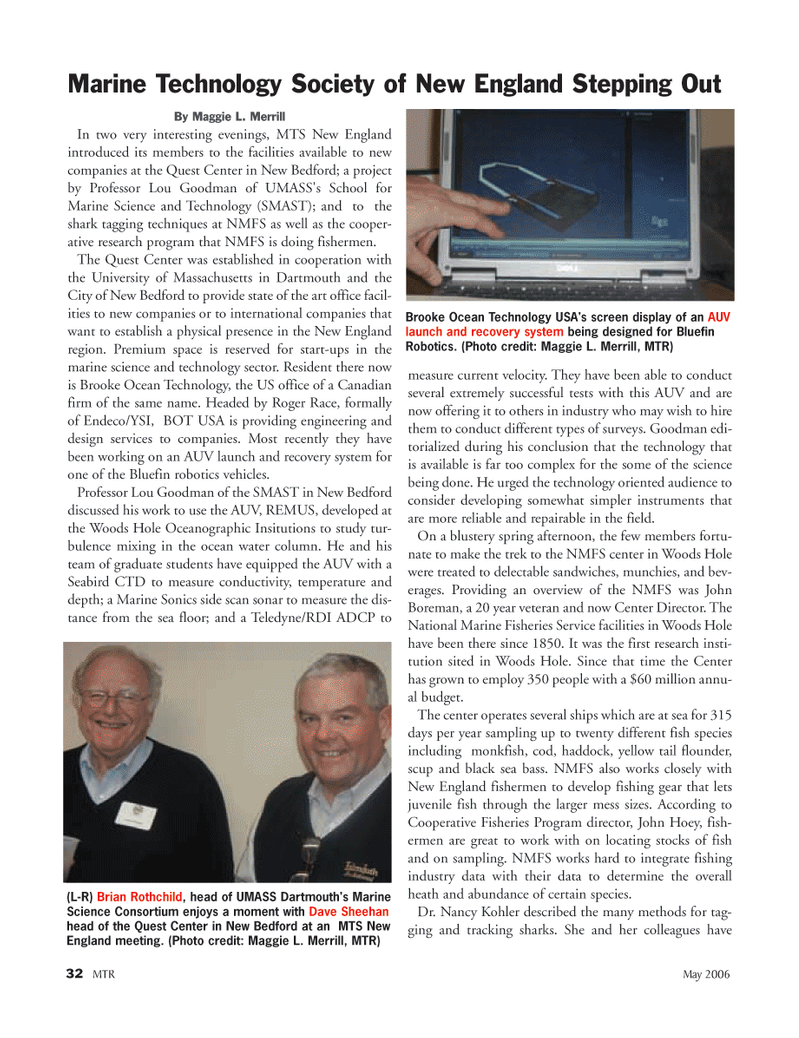
Page 32: of Marine Technology Magazine (May 2006)
The Communications Edition
Read this page in Pdf, Flash or Html5 edition of May 2006 Marine Technology Magazine
32 MTR May 2006
By Maggie L. Merrill
In two very interesting evenings, MTS New England introduced its members to the facilities available to new companies at the Quest Center in New Bedford; a project by Professor Lou Goodman of UMASS's School for
Marine Science and Technology (SMAST); and to the shark tagging techniques at NMFS as well as the cooper- ative research program that NMFS is doing fishermen.
The Quest Center was established in cooperation with the University of Massachusetts in Dartmouth and the
City of New Bedford to provide state of the art office facil- ities to new companies or to international companies that want to establish a physical presence in the New England region. Premium space is reserved for start-ups in the marine science and technology sector. Resident there now is Brooke Ocean Technology, the US office of a Canadian firm of the same name. Headed by Roger Race, formally of Endeco/YSI, BOT USA is providing engineering and design services to companies. Most recently they have been working on an AUV launch and recovery system for one of the Bluefin robotics vehicles.
Professor Lou Goodman of the SMAST in New Bedford discussed his work to use the AUV, REMUS, developed at the Woods Hole Oceanographic Insitutions to study tur- bulence mixing in the ocean water column. He and his team of graduate students have equipped the AUV with a
Seabird CTD to measure conductivity, temperature and depth; a Marine Sonics side scan sonar to measure the dis- tance from the sea floor; and a Teledyne/RDI ADCP to measure current velocity. They have been able to conduct several extremely successful tests with this AUV and are now offering it to others in industry who may wish to hire them to conduct different types of surveys. Goodman edi- torialized during his conclusion that the technology that is available is far too complex for the some of the science being done. He urged the technology oriented audience to consider developing somewhat simpler instruments that are more reliable and repairable in the field.
On a blustery spring afternoon, the few members fortu- nate to make the trek to the NMFS center in Woods Hole were treated to delectable sandwiches, munchies, and bev- erages. Providing an overview of the NMFS was John
Boreman, a 20 year veteran and now Center Director. The
National Marine Fisheries Service facilities in Woods Hole have been there since 1850. It was the first research insti- tution sited in Woods Hole. Since that time the Center has grown to employ 350 people with a $60 million annu- al budget.
The center operates several ships which are at sea for 315 days per year sampling up to twenty different fish species including monkfish, cod, haddock, yellow tail flounder, scup and black sea bass. NMFS also works closely with
New England fishermen to develop fishing gear that lets juvenile fish through the larger mess sizes. According to
Cooperative Fisheries Program director, John Hoey, fish- ermen are great to work with on locating stocks of fish and on sampling. NMFS works hard to integrate fishing industry data with their data to determine the overall heath and abundance of certain species.
Dr. Nancy Kohler described the many methods for tag- ging and tracking sharks. She and her colleagues have
Marine Technology Society of New England Stepping Out
Brooke Ocean Technology USA's screen display of an AUV launch and recovery system being designed for Bluefin
Robotics. (Photo credit: Maggie L. Merrill, MTR) (L-R) Brian Rothchild, head of UMASS Dartmouth's Marine
Science Consortium enjoys a moment with Dave Sheehan head of the Quest Center in New Bedford at an MTS New
England meeting. (Photo credit: Maggie L. Merrill, MTR)
MTR#4 (17-32).qxd 5/8/2006 9:57 AM Page 32

 31
31

 33
33
